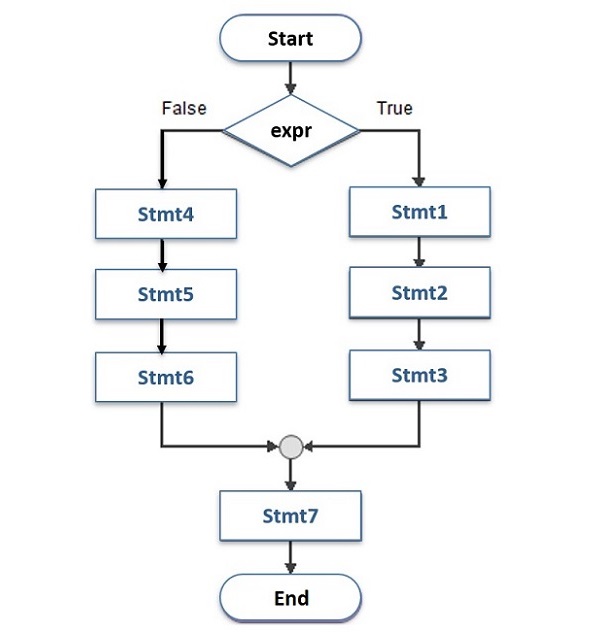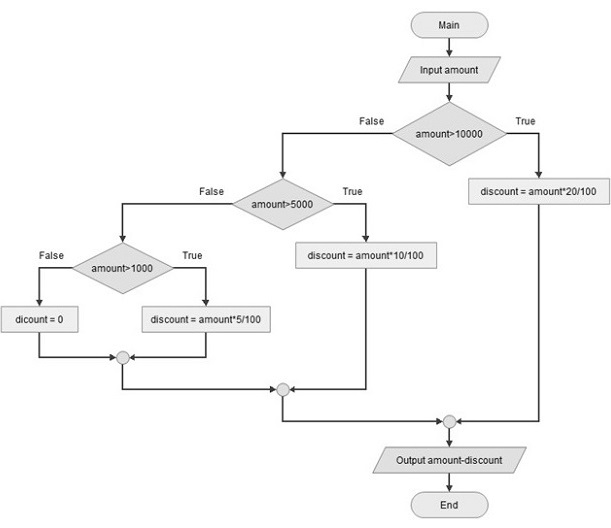
- Python Basics
- Python - Home
- Python - Overview
- Python - History
- Python - Features
- Python vs C++
- Python - Hello World Program
- Python - Application Areas
- Python - Interpreter
- Python - Environment Setup
- Python - Virtual Environment
- Python - Basic Syntax
- Python - Variables
- Python - Data Types
- Python - Type Casting
- Python - Unicode System
- Python - Literals
- Python - Operators
- Python - Arithmetic Operators
- Python - Comparison Operators
- Python - Assignment Operators
- Python - Logical Operators
- Python - Bitwise Operators
- Python - Membership Operators
- Python - Identity Operators
- Python - Operator Precedence
- Python - Comments
- Python - User Input
- Python - Numbers
- Python - Booleans
- Python Control Statements
- Python - Control Flow
- Python - Decision Making
- Python - If Statement
- Python - If else
- Python - Nested If
- Python - Match-Case Statement
- Python - Loops
- Python - for Loops
- Python - for-else Loops
- Python - While Loops
- Python - break Statement
- Python - continue Statement
- Python - pass Statement
- Python - Nested Loops
- Python Functions & Modules
- Python - Functions
- Python - Default Arguments
- Python - Keyword Arguments
- Python - Keyword-Only Arguments
- Python - Positional Arguments
- Python - Positional-Only Arguments
- Python - Arbitrary Arguments
- Python - Variables Scope
- Python - Function Annotations
- Python - Modules
- Python - Built in Functions
- Python Strings
- Python - Strings
- Python - Slicing Strings
- Python - Modify Strings
- Python - String Concatenation
- Python - String Formatting
- Python - Escape Characters
- Python - String Methods
- Python - String Exercises
- Python Lists
- Python - Lists
- Python - Access List Items
- Python - Change List Items
- Python - Add List Items
- Python - Remove List Items
- Python - Loop Lists
- Python - List Comprehension
- Python - Sort Lists
- Python - Copy Lists
- Python - Join Lists
- Python - List Methods
- Python - List Exercises
- Python Tuples
- Python - Tuples
- Python - Access Tuple Items
- Python - Update Tuples
- Python - Unpack Tuples
- Python - Loop Tuples
- Python - Join Tuples
- Python - Tuple Methods
- Python - Tuple Exercises
- Python Sets
- Python - Sets
- Python - Access Set Items
- Python - Add Set Items
- Python - Remove Set Items
- Python - Loop Sets
- Python - Join Sets
- Python - Copy Sets
- Python - Set Operators
- Python - Set Methods
- Python - Set Exercises
- Python Dictionaries
- Python - Dictionaries
- Python - Access Dictionary Items
- Python - Change Dictionary Items
- Python - Add Dictionary Items
- Python - Remove Dictionary Items
- Python - Dictionary View Objects
- Python - Loop Dictionaries
- Python - Copy Dictionaries
- Python - Nested Dictionaries
- Python - Dictionary Methods
- Python - Dictionary Exercises
- Python Arrays
- Python - Arrays
- Python - Access Array Items
- Python - Add Array Items
- Python - Remove Array Items
- Python - Loop Arrays
- Python - Copy Arrays
- Python - Reverse Arrays
- Python - Sort Arrays
- Python - Join Arrays
- Python - Array Methods
- Python - Array Exercises
- Python File Handling
- Python - File Handling
- Python - Write to File
- Python - Read Files
- Python - Renaming and Deleting Files
- Python - Directories
- Python - File Methods
- Python - OS File/Directory Methods
- Object Oriented Programming
- Python - OOPs Concepts
- Python - Object & Classes
- Python - Class Attributes
- Python - Class Methods
- Python - Static Methods
- Python - Constructors
- Python - Access Modifiers
- Python - Inheritance
- Python - Polymorphism
- Python - Method Overriding
- Python - Method Overloading
- Python - Dynamic Binding
- Python - Dynamic Typing
- Python - Abstraction
- Python - Encapsulation
- Python - Interfaces
- Python - Packages
- Python - Inner Classes
- Python - Anonymous Class and Objects
- Python - Singleton Class
- Python - Wrapper Classes
- Python - Enums
- Python - Reflection
- Python Errors & Exceptions
- Python - Syntax Errors
- Python - Exceptions
- Python - try-except Block
- Python - try-finally Block
- Python - Raising Exceptions
- Python - Exception Chaining
- Python - Nested try Block
- Python - User-defined Exception
- Python - Logging
- Python - Assertions
- Python - Built-in Exceptions
- Python Multithreading
- Python - Multithreading
- Python - Thread Life Cycle
- Python - Creating a Thread
- Python - Starting a Thread
- Python - Joining Threads
- Python - Naming Thread
- Python - Thread Scheduling
- Python - Thread Pools
- Python - Main Thread
- Python - Thread Priority
- Python - Daemon Threads
- Python - Synchronizing Threads
- Python Synchronization
- Python - Inter-thread Communication
- Python - Thread Deadlock
- Python - Interrupting a Thread
- Python Networking
- Python - Networking
- Python - Socket Programming
- Python - URL Processing
- Python - Generics
- Python Libraries
- NumPy Tutorial
- Pandas Tutorial
- SciPy Tutorial
- Matplotlib Tutorial
- Django Tutorial
- OpenCV Tutorial
- Python Miscellenous
- Python - Date & Time
- Python - Maths
- Python - Iterators
- Python - Generators
- Python - Closures
- Python - Decorators
- Python - Recursion
- Python - Reg Expressions
- Python - PIP
- Python - Database Access
- Python - Weak References
- Python - Serialization
- Python - Templating
- Python - Output Formatting
- Python - Performance Measurement
- Python - Data Compression
- Python - CGI Programming
- Python - XML Processing
- Python - GUI Programming
- Python - Command-Line Arguments
- Python - Docstrings
- Python - JSON
- Python - Sending Email
- Python - Further Extensions
- Python - Tools/Utilities
- Python - GUIs
- Python Useful Resources
- Python Compiler
- NumPy Compiler
- Matplotlib Compiler
- SciPy Compiler
- Python - Programming Examples
- Python - Quick Guide
- Python - Useful Resources
- Python - Discussion
Python if-else Statement
Python if else Statement
Along with the if statement, else keyword can also be optionally used. Python if else statement provides an alternate block of statements to be executed if the Boolean expression (in if statement) is not true.
Python if else Syntax
The syntax of an if else statement is:
if boolean_expression: # code block to be executed # when boolean_expression is true else: # code block to be executed # when boolean_expression is false
Python if else Flowchart
This flowchart shows how else block is used.

If the expr is True, block of stmt1,2,3 is executed then the default flow continues with stmt7. However, the If expr is False, block stmt4,5,6 runs then the default flow continues.
Python implementation of the above flowchart is as follows −
if expr==True: stmt1 stmt2 stmt3 else: stmt4 stmt5 stmt6 Stmt7
Python if else Statement Example
Let us understand the use of else clause with following example. The variable age can take different values. If the expression "age > 18" is true, message you are eligible to vote is displayed otherwise not eligible message should be displayed. Following flowchart illustrates this logic.

Its Python implementation is simple.
age=25
print ("age: ", age)
if age >=18:
print ("eligible to vote")
else:
print ("not eligible to vote")
To begin, set the integer variable "age" to 25.
Then use the if statement with "age>18" expression followed by ":" which starts a block; this will come in action if "age>=18" is true.
To provide else block, use else: the ensuing indented block containing message not eligible will be in action when "age>=18" is false.
On executing this code, you will get the following ouput −
age: 25 eligible to vote
To test the the else block, change the age to 12, and run the code again.
age: 12 not eligible to vote
Python if elif else Statement
The if elif else statement allows you to check multiple expressions for TRUE and execute a block of code as soon as one of the conditions evaluates to TRUE.
Similar to the else statement, the elif statement is optional. However, unlike else, for which there can be at the most one statement; there can be an arbitrary number of elif statements following an if.
Python if elif else Syntax
if expression1: statement(s) elif expression2: statement(s) elif expression3: statement(s) else: statement(s)
How if elif else Works?
Let us understand how if elif else works, with the help of following example.
The discount structure used in an earlier example is modified to different slabs of discount −
20% on amount exceeding 10000,
10% for amount between 5-10000,
5% if it is between 1 to 5000.
no discount if amount<1000
The following flowchart illustrates these conditions −

Example
We can write a Python code for the above logic with if-else statements −
amount = 2500
print('Amount = ',amount)
if amount > 10000:
discount = amount * 20 / 100
else:
if amount > 5000:
discount = amount * 10 / 100
else:
if amount > 1000:
discount = amount * 5 / 100
else:
discount = 0
print('Payable amount = ',amount - discount)
Set amount to test all possible conditions: 800, 2500, 7500 and 15000. The outputs will vary accordingly −
Amount: 800 Payable amount = 800 Amount: 2500 Payable amount = 2375.0 Amount: 7500 Payable amount = 6750.0 Amount: 15000 Payable amount = 12000.0
While the code will work perfectly ok, if you look at the increasing level of indentation at each if and else statement, it will become difficult to manage if there are still more conditions.
The elif statement makes the code easy to read and comprehend.
Elif is short for else if. It allows the logic to be arranged in a cascade of elif statements after the first if statement. If the first if statement evaluates to false, subsequent elif statements are evaluated one by one and comes out of the cascade if any one is satisfied.
Last in the cascade is the else block which will come in picture when all preceding if/elif conditions fail.
Python if elif else Statement Example
amount = 2500
print('Amount = ',amount)
if amount > 10000:
discount = amount * 20 / 100
elif amount > 5000:
discount = amount * 10 / 100
elif amount > 1000:
discount = amount * 5 / 100
else:
discount=0
print('Payable amount = ',amount - discount)
Set amount to test all possible conditions: 800, 2500, 7500 and 15000. The outputs will vary accordingly −
Amount: 800 Payable amount = 800 Amount: 2500 Payable amount = 2375.0 Amount: 7500 Payable amount = 6750.0 Amount: 15000 Payable amount = 12000.0
To Continue Learning Please Login